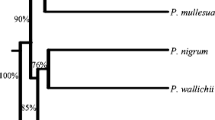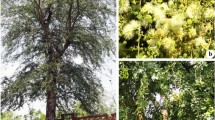Abstract
Despite the economic importance of mahoganies (Meliaceae) little is known of the pattern of genetic variation within this family of tropical trees. We describe the application of a polymerase chain reaction (PCR)-based polymorphic DNA assay procedure random amplified polymorphic DNAs (RAPDs) to assess the extent of genetic variation between eight mahogany species from four genera. Pronounced genetic differentiation was found between the species and genera. There was a clear separation of Cedrela odorata from the other species, with 95% of the variable amplification products differing, whereas Lovoa trichilioides, Khaya spp. and Swietenia spp. were more closely grouped. These results are consistent with the current taxonomic viewpoint. A number of markers were found to be diagnostic for particular species, which could be of value in determining the status of putative hybrids. The application of RAPDs to the study of genetic variation in mahoganies is discussed in the context of developing genetic conservation and improvement strategies for these species.
Similar content being viewed by others
References
Burley J, Nikles DG (eds) (1973) Tropical provenance and progeny research and international cooperation. (Proc IUFRO Working Party Meeting at Nairobi, Kenya.) Commonwealth Forestry Institute, Oxford
Chalmers KJ, Waugh R, Sprent JI, Simons AJ, Powell W (1992) Detection of genetic variation between and within populations of Gliricidia sepium and G. maculata using RAPD markers. Heredity 69:465–472
Chaplin GE (1980) Progress with provenance exploration and seed collection of Cedrela spp. In: Proc 11th Commonwealth Forestry Conf, Commonwealth Forestry Institute, Oxford, UK, pp 1–17
Gawel NJ, Jarret RL (1991) A modified CTAB DNA extraction procedure for Musa and Ipomaea. Plant Mol Biol Rep 9:262–266
Hadrys H, Balick M, Schierwater B (1992) Applications of randomly amplified polymorphic DNA (RAPD) in molecular ecology. Mol Ecol 1:55–63
Howard FW, Verkade SD, De Filippis JD (1988) Propagation of West Indies, Honduran and hybrid mahoganies by cuttings, compared with seed propagation. Proc Fla State Hortis Soc 101:296–298
Hu J, Quiros CF (1991) Identification of broccoli and cauliflower cultivars with RAPD markers. Plant Cell Rep 10:505–511
Kaemmer D, Afza R, Weising K, Kahl G, Novak FJ (1992) Oligonucleotide and amplification fingerprinting of wild species and cultivars of banana (Musa spp.). Bio/Technology 10:1030–1035
Kempton R, McNicol J (1990) Graphical methods for multivariate data. Scottish Agricultural Statistics Service, pp 1–67
Knees SG, Gardner MF (1983) Mahoganies: candidates for the Red Data Book. Oryx 17:88–92
Lamb FB (1966) Mahogany of tropical America. Its ecology and management. The University of Michigan Press, Ann Arbor, Mich.
Newbury HJ, Ford-Lloyd BV (1993) The use of RAPD for assessing variation in plants. Pl Growth Reg 12:43–51.
Newton AC (1993) Prospects for growing mahogany in plantations. In: Proc 2nd Pan-Am Furniture Manufacturers' Symp Trop Hardwoods. Grand Rapids, Michigan: Center for Environmental Study, Grand Rapids, Mich., pp 97–108
Newton AC, Mesén JF, Leakey RRB (1991) ITE/CATIE link. Interim report to the ODA. Institute of Terrestrial Ecology, Edinburgh, UK
Newton AC, Mesén JF, Leakey RRB (1992) ITE/CATIE link. Second interim report to the ODA. Institute of Terrestrial Ecology, Edinburgh, UK
Newton AC, Baker P, Ramnarine S, Mesén JF, Leakey RRB (1993a) The mahogany shoot borer: prospects for control. For Ecol Manage 57:301–328
Newton AC, Leakey RRB, Mesén JF (1993b) Genetic variation in mahoganies: Its importance, utilization and conservation. Biodiversity and Conservation 2:114–126
Newton AC, Leakey RRB, Powell W, Chalmers K, Waugh R, Tchoungjeu Z, Mathias PJ, Alderson PG, Mesén JF, Baker P, Ramnarine S (1993c) Domestication of mahoganies. In: Tropical trees: the potential for domestication. Leakey RRB, Newton AC (eds) HMSO, London (in press).
Nikles DG, Burley J, Barnes RD (eds) (1978) Progress and problems of genetic improvement of tropical forest trees. Proc IUFRO Working Party Meeting Brisbane Australia. Commonwealth Forestry Institute, Oxford, UK
Orozco-Castillo C, Chalmers KJ, Waugh R, Powell W (1994) Detection of genetic diversity and selective gene introgression in coffee using RAPD markers. Theor Appl Genet 87:934–940
Read M (1990) Mahogany — forests or furniture? Brighton, UK: Fauna and Flora Preservation Society, Brighton, UK
Rodan BD, Newton AC, Verissimo A (1992) Mahogany conservation: status and policy initiatives. Environ Conservation 19:331–338
Styles BT (1981) Swietenioideae. In: Flora Neotropica Monograph No 28: Meliaceae New York: New York Botanical Garden, New York, pp 359–421
Waugh R, Powell W (1992) Using RAPD markers for crop improvement. Trends Biotechnal 10:186–191
Weaver PL, Bauer GP (1986) Growth, survival and shoot borer damage in mahogany plantings in the Luquillo Forest in Puerto Rico. Turrialba 36:509–522
Welsh J, McClelland M (1990) Fingerprinting genomes using PCR with arbitrary primers. Nucleic Acids Res 18:7213–7218
Welsh J, Honeycutt RJ, McClelland M, Sobral BWS (1991) Parentage determination in maize hybrids using the arbitrarily primed polymerase chain reaction (AP-PCR). Theor Appl Genet 82:473–476.
Whitmore JL, Hinojosa G (1977) Mahogany (Swietenia) hybrids. US Department of Agriculture Forest Service Research Paper ITF-23, Rio Piedras, Puerto Rica, 8 pp.
Whitmore TC (1990) An introduction to tropical rain forests. Clarendon Press, Oxford
Wilde J, Waugh R, Powell W (1992) Genetic fingerprinting of Theobroma clones using randomly amplified polymorphic DNA markers. Theor Appl Genet 83:871–877
Williams JGK, Kubelik AR, Livak KJ, Rafalski JA, Tingey SV (1990) DNA polymorphisms amplified by arbitrary primers are useful as genetic markers. Nucleic Acids Res 18:6531–6535
Author information
Authors and Affiliations
Additional information
Communicated by J. Mac Key
Rights and permissions
About this article
Cite this article
Chalmers, K.J., Newton, A.C., Waugh, R. et al. Evaluation of the extent of genetic variation in mahoganies (Meliaceae) using RAPD markers. Theoret. Appl. Genetics 89, 504–508 (1994). https://doi.org/10.1007/BF00225387
Received:
Accepted:
Issue Date:
DOI: https://doi.org/10.1007/BF00225387




